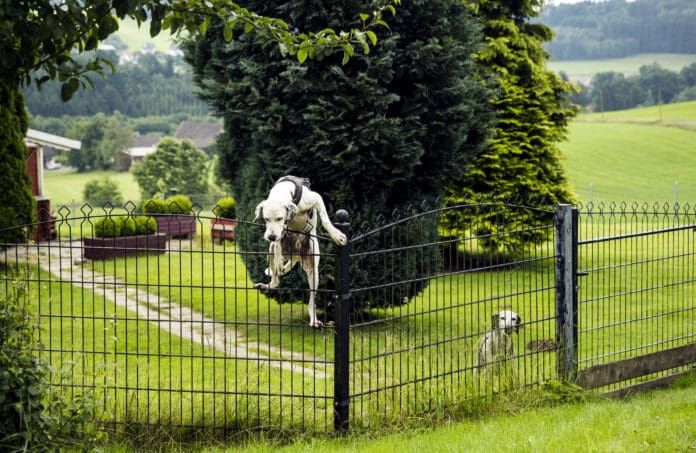[Updated August 21, 2017]
RUNAWAY DOG OVERVIEW
– Make sure your fence is secure before you bring that new dog home. Even if it keeps your current dogs safely confined, a canine newcomer may have new talents that test your confinement system.
– Be careful any time you put your dog in a new containment area. Check the area first to ensure it is secure, and watch him after you put him in to be sure he’s not testing the fence.
– Consider the safest approach – always keep your dog indoors when you’re not home.
Otis the Bloodhound was an opportunistic runaway dog. I discovered his talent one day while working at the front desk at the Marin Humane Society, early in my animal protection career. A woman came in asking if we might know where a Bloodhound lived, because he kept visiting her house every day. He was charming, she said, but she worried that he might get hit by a car.
A Bloodhound owner myself at the time, I was curious where this errant Bloodhound might live; it’s not a very common breed. But when I asked the woman for her address, I was dismayed to hear she lived around the corner from me. Could it possibly be MY safely fenced dog who was making house calls around the neighborhood?
It was, indeed. Unbeknownst to me, Otis had discovered a hole in the fence behind some dense bushes. He waited every morning until I was gone, crawled out the hole, spent his day visiting neighbors, and returned home in time to greet me innocently at my back door.
I was lucky. Otis wasn’t a dedicated escape artist – a solid patch to the fence ended his wanderings. Other owners often work much harder to keep their canine fugitives safe at home.
Dogs Who Become Skilled Escape Artists
Roaming is an innate behavior for dogs. They are hunters and scavengers, and left to their own devices will wander a territory far larger than the average backyard. Escaping, however, is a learned behavior. Dogs who are given the opportunity to escape often do. Once they figure out how, they will try harder and harder, even when the fence is belatedly fortified. Dogs who become escape artists hone their skills to a fine edge. Keeping them safely confined at home where they belong can be a huge challenge. Our nation’s animal shelters are full of escape artists.
The best avenue for managing a dog’s wanderlust is to prevent him from wandering in the first place. The problem starts when you bring home the new puppy before you are fully prepared, promising to put up that fence before Rover grows up.
A tiny puppy won’t wander far from the back stoop, even when you leave him out on his own for a bit. Before you know it, though, Rover is six months old, already has a habit of making neighborhood rounds, and you still haven’t finished the fence. When Mr. Jones from down the road calls you up and threatens to shoot Rover if he chases his goats one more time, you rush to the hardware store to buy some metal fence posts and hog wire. Hastily you throw up a pen in the backyard that attaches to the back deck. “That should hold him until I get the rest of those post holes dug!” you think.
As you settle yourself back on the sofa to watch the last half of the football game, Rover is already testing the fence; he’s late for his daily visit to the Smith’s garbage can! He checks out the gate latch, but it doesn’t yield to his tentative pawing and gnawing. He trots around the inside of the enclosure, searching for a way out.
In the far corner he finds a three-inch gap between the wire and the ground and pokes his nose under. Getting his nose on the other side of the fence encourages him to try harder. He starts to worm his way under. The soft ground gives way beneath his claws. He digs harder. Before you can say “end zone,” he’s free, headed for the Smith’s omelet scraps and bacon drippings. You eventually retrieve him and fill the hole, but the damage is done. Rover is on his way to a lifetime career as a master escape artist.
Preferred Escape Methods Depend on the Dog’s Breed
Whether your dog’s escape efforts focus on tooth or claw or he excels in feats of aerial accomplishment depends both on genetics and learning. Dogs who are genetically programmed to dig, such as Terriers, are likely to burrow under the fence, especially if a handy soft spot presents itself.
If, however, the first weak spot in the fence is a loose board, we can inadvertently train Rover and our Terrier to eat their way through fences, turning them into beavers rather than burrowers. Once Rover discovers that the fence is breachable, he’ll test every spot where his teeth can gain purchase, and you’ll forever spend your football-watching time patching his holes.
Herding dogs such as Border Collies and sporting breeds like Labradors have a natural ability to leap tall buildings in a single bound. Given the opportunity, they’ll often make jumping fences their specialty.
However, you can inadvertently teach a less-athletic dog to bound over fences by starting small.
Confident that a four-foot fence will contain the Beagle-mix you just adopted from the shelter, you leave him in the backyard and go off to work. That night, your new dog greets you in the driveway after terrorizing cottontails in the neighbors’ woods all day. You raise the fence six inches, positive that this will hold him. Flush from his exploits the day before, your dog has to struggle a little harder to make it over 4’6″, but nothing breeds success like success. A little extra oomph, and he’s out again for another rousing day of bunny-bashing.
You raise the fence to five feet this time, absolutely sure there’s no way he can get over that. But again, even more confident of his jumping prowess, your dog tries a wee bit harder, and he’s up and over. There’s a good chance that if you had started with a five-foot fence Snoopy never would have tried to jump it at all. What you’ve done is taught him to jump higher and higher, consistently reinforcing his belief that if he just tries hard enough he can make it.
Bolters have learned to watch for a moment of human inattention, then charge through the tiniest crack in the gate or door.
While the other escape methods work best in the absence of humans, bolting requires the unintentional complicity of the visitor who doesn’t know (or the family member who forgets) that Dash must be manacled and hog-tied before a door is opened to the outside world.
Once again, prevention is the better part of valor. If Dash is taught from early days to wait politely at a door until invited out, he won’t learn the fine art of door-darting.
Preventing Your Dog from Getting Out
You’ve heard this from me before, and you’ll hear it from me again. It’s always easier to prevent a behavior problem from happening than it is to fix it after the fact. There’s no excuse for letting a puppy learn how to be an escape artist. Prevention measures are relatively simple. Don’t let your puppy learn that roaming is rewarding – keep him at home, and stop any embryonic escape attempts in their tracks by taking the following prophylactic measures:
• Provide a safe, secure enclosure. Before the new puppy comes home, make sure your fence is flush to the ground, or even buried a few inches. Check for rotten spots, and crawl behind shrubs and brush to look for holes or loose boards.
• Go overboard on fence height. Raise the fence to at least five feet for a small dog (perhaps higher for very athletic small dogs like Jack Russell Terriers) and six feet for medium to large dogs. Make sure there are no woodpiles, doghouses, deck railings, or other objects close enough to the fence to provide a launch pad.
• Teach your pup to wait at doors until invited through. Use “Wait!” at every door to the outside world, every time you open it, whether you are going to let him go through it or not (see “Training Your Dog to Stay Using Cues,” May 2001).
• Install dog-proof latches on gates. There’s no point in waiting until after he’s been hit by a car to discover that Rover can learn to work the latch. In fact, a padlock will prevent accidental release from the outside by a visitor or intruder at the same time it keeps Rover from practicing his latch-opening skills.
• Minimize male dogs’ motivation to roam by neutering at a young age (eight weeks or not long thereafter), and provide ample exercise and companionship at home (see “When is a Good Time to Spay or Neuter?” June 2000).
• Consider keeping the dog indoors when you’re not home. Boredom and loneliness provide strong motivation to escape, and Rover has plenty of time to plan and execute the great escape when you are not there to interrupt unwanted behaviors such as digging under and chewing through fences.
Retraining Dogs Who Run Away
What if it’s too late for prevention? Maybe you adopted Rover from the shelter after his last adopter taught him to jump a six-foot fence, and then returned him because he kept escaping. Do you give up on Rover, too? Not at all. There are lots of steps you can take to fortify your defenses and keep your escape artist at home, depending on his proclivities.
• Bounders: If you have a scaler, who hooks his nails in the chain link and climbs up and over, you can cover the inside of the fence with a flat, solid surface so his nails can’t get a purchase. A relatively new material, FRP (fiberglass reinforced plastic) that is now regularly used in animal shelters may withstand tooth and nail, but it may be prohibitively expensive if you have a large fenced area.
Or, you can install a “roof” at the top of the fence that comes in at a 90-degree angle; he won’t be able to reach behind his head and pull himself backward over the ledge when he gets to the top. Some people use wire mesh to create an angled-in barrier – similar to those at the top of prison fences, only without the razor wire! – that impedes jumping.
Another option that I’ve seen work is to top your fences with a “roll bar” that prevents your dog from getting a purchase at the top of the fence and pulling himself over. This is easily installed by running a wire or rope through sections of fat PVC pipe and hanging them along the top of the fence.
If you have a sailor, who gets a good running start and clears the fence with the greatest of ease, plant a hedge or place some other obstacle in his takeoff zone, interrupting his stride and making it impossible for him to jump. If you put your last fence extension inward at a 45-degree angle you may also fool his eye and foil his leap.
• Bolters: The dog who bolts through open doors needs an airlock – a system of double gates so that if he makes it through one, he is still contained behind the next. Self-closing gate springs are a must, to prevent visitors and family members from being careless twice in a row. A good solid recall – teaching Dash to come when called – taught with positive methods, of course, is an excellent backup plan for the door darter (see “Why a Reliable Recall is So Important,” December, 2000). Family members also need to remember not to panic and chase when Dash slips out – a good game of keep-away just makes door-darting more fun for the dog.
• Burrowers: If you’re going to bury the fence for a dedicated burrower, bury deep – at least six inches to a foot. If you bury it two inches, you’ll just teach him to dig deeper. You might do better setting the fence in cement, or lining your fence trench with large rocks or small boulders. You definitely need a cement pad at the gate, since you can’t bury the gate.
• Beavers: If Bucky has learned to gnaw his way through your fence you could be in big trouble. Lining the inside of the fence with heavy-duty wire – like chain link – may stop him. It may not, however, and he may break teeth in his attempts to eat his way out. Sheets of FRP are good for this also. Cement block walls can be effective, but may not be aesthetically pleasing. Ceramic tiles can be glued to the blocks to make them more attractive, but they’re not cheap.
A Shocking Solution?
Many dog owners are turning to electric shock collars to keep their dogs contained. Non-visible electronic fences are quite the rage, especially in communities where shortsighted homeowner regulations prohibit the installation of physical fences. Many dog owners are pleased with the results – no unsightly fence to impede their view of the sunset, and Rover magically stays within his delineated boundaries. Many dog owners are not so pleased. There are a myriad of things that can fail with non-visible shock fencing systems. Here are just a few:
■ For most dogs, there is a stimulus strong enough to entice the dog through the fence. For some, it might be that bunny or squirrel venturing a tad too close. Once the dog is outside the fence line, he’s rarely motivated to brave the shock to get back in.
■ Some dogs learn that the shock stops once they cross the line. Dogs who are determined to escape can learn to grit their teeth and risk one shock to get to the other side.
■ Shock collars are a punishment tool, and their use risks all the potential negative side effects of punishment. They can cause fear and/or aggression. If a dog receives a shock while a child is walking by, he may associate the shock with the child and become aggressive toward children. Or mail carriers. Or joggers. Or other dogs. Some dogs have become terrified and refuse to go into their own yards after receiving shocks from the collar during the training process.
■ Electronic equipment can fail. Batteries die, and when the dog no longer hears the warning beep he is free to come and go as he pleases. Some collars have malfunctioned and delivered repeated shocks to hapless, helpless dogs until their owners arrived home from work at the end of the day to rescue them from their torture.
■ The non-visible fence does not, of course, provide the dog with any protection from intruders, so Rover is at the mercy of other dogs or humans who may enter the yard and do bad things.
■ As an advocate of positive, dog-friendly training methods, I simply reject the idea of shocking dogs around the neck for our convenience. I would much prefer a chain-link dog pen with a top, set on a cement pad, for the master escape artist.
Most dog owners want to be able to give Rover the freedom to play in the yard, however, so when all else fails, I am a bit less loath to use electric shock in a situation where the dog learns by doing. I have, on rare occasion, suggested the use of a single strand of battery-powered electric fence wire, installed at nose level on the inside of the physical fence.
While a shock to the neck that comes out of nowhere seems to confuse and even terrify a good number of dogs, an “ouch!” to the nose when they touch something seems to make more sense. After one, or maybe two touches, most dogs leave the fence alone without apparent long-term psychological trauma. A last resort, perhaps, and a very aversive one, but preferable to being hit by a car.
Any Dog Can Escape a Yard
I’m far more careful now than I was in the Otis days; my dogs are never left in the backyard if no one is home to monitor their activities. Still, that doesn’t mean that accidents don’t happen. Just the other day, my phone rang. I answered, and it was Helen, my assistant, calling from the training center a few hundred feet from the house.
“I have Lucy,” she said.
WHAT?!
Lucy was supposed to be safely in the backyard! I dashed out to find the back gate open – left that way by the usually-very-careful guy who mows our lawn. Tucker was safely indoors, Dubhy and Katie were still in the backyard – only Lucy had made the great escape, and she hadn’t gone far.
It can happen to any of us. I was just thankful someone was home.






